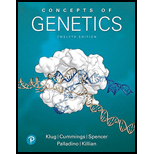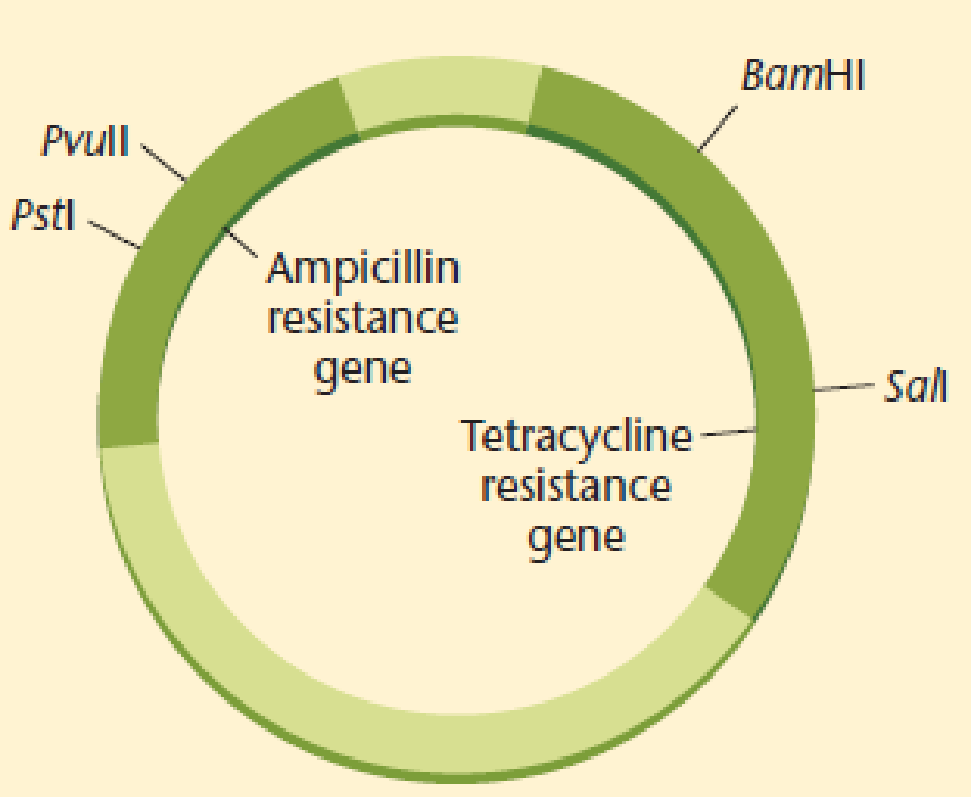
Concept explainers
A plasmid that is both ampicillin and tetracycline resistant is cleaved with Pstl, which cleaves within the ampicillin resistance gene. The cut plasmid is ligated with Pstl-digested Drosophila DNA to prepare a genomic library, and the mixture is used to transform E. coli K12.

- (a) Which antibiotic should be added to the medium to select cells that have incorporated a plasmid?
- (b) If recombinant cells were plated on medium containing ampicillin or tetracycline and medium with both antibiotics, on which plates would you expect to see growth of bacteria containing plasmids with Drosophila DNA inserts?
- (c) How can you explain the presence of colonies that are resistant to both antibiotics?
(a)
To determine: The antibiotic that an individual should add to the medium to select cells that contain the recombinant plasmid.
Introduction: Plasmid refers to an circular, extrachromosomal DNA (deoxyribonucleic acid) molecule that replicates chromosome independently.
Explanation of Solution
The gene that confers resistance to tetracycline is intact in the recombinant plasmid. An individual would add tetracycline to the medium to select the recombinant plasmd in the cells. In the medium, the bacteria that have been transformed with recombinant plasmid will be resistant to tetracycline.
Thus, an individual would use tetracycline to select cells that contain the recombinant plasmid.
(b)
To determine: The plates on which an individual might see the growth of bacteria having plasmids with Drosophila DNA inserts.
Introduction: Genetically modified bacterial plasmids were the first developed vectors, used for cloning purpose.
Explanation of Solution
Cloning is a important process in which bacterial cells containing recombinant DNA can be readily identified. This process is also accomplished is through the use of selectable marker genes. Antibiotic resistant genes provide very effective selectable marker genes. Therefore, the colonies that grow on tetracycline medium but do not grow on ampicillin medium would contain the Drosophila DNA insert.
Thus, colonies that only grow in tetracycline medium probably contain the Drosophila DNA insert.
(c)
To determine: The reason that some colonies can grow on tetracycline medium as well as ampicillin medium.
Introduction: Plasmids have an origin of replication (ori) site, which makes it possible to produce several hundred copies of a plasmid in a single host cell.
Explanation of Solution
When performing cloning process, it is not necessary for incorporation of all DNA plasmids need to be cloned. A plasmid cut with a restriction enzyme generating sticky ends can self-ligate if cut ends of the plasmid rejoin. Also, if cleavage with PstI was incomplete, then no change in biological characteristics of the uncut plasmid would be expected.
Thus, self-ligation of plasmid and incomplete cleavage with PstI are responsible for the growth of colonies that are resistant to both antibiotics.
Want to see more full solutions like this?
Chapter 20 Solutions
EBK CONCEPTS OF GENETICS
- Ch.23 How is Salmonella able to cross from the intestines into the blood? A. it is so small that it can squeeze between intestinal cells B. it secretes a toxin that induces its uptake into intestinal epithelial cells C. it secretes enzymes that create perforations in the intestine D. it can get into the blood only if the bacteria are deposited directly there, that is, through a puncture — Which virus is associated with liver cancer? A. hepatitis A B. hepatitis B C. hepatitis C D. both hepatitis B and C — explain your answer thoroughlyarrow_forwardCh.21 What causes patients infected with the yellow fever virus to turn yellow (jaundice)? A. low blood pressure and anemia B. excess leukocytes C. alteration of skin pigments D. liver damage in final stage of disease — What is the advantage for malarial parasites to grow and replicate in red blood cells? A. able to spread quickly B. able to avoid immune detection C. low oxygen environment for growth D. cooler area of the body for growth — Which microbe does not live part of its lifecycle outside humans? A. Toxoplasma gondii B. Cytomegalovirus C. Francisella tularensis D. Plasmodium falciparum — explain your answer thoroughlyarrow_forwardCh.22 Streptococcus pneumoniae has a capsule to protect it from killing by alveolar macrophages, which kill bacteria by… A. cytokines B. antibodies C. complement D. phagocytosis — What fact about the influenza virus allows the dramatic antigenic shift that generates novel strains? A. very large size B. enveloped C. segmented genome D. over 100 genes — explain your answer thoroughlyarrow_forward
- What is this?arrow_forwardMolecular Biology A-C components of the question are corresponding to attached image labeled 1. D component of the question is corresponding to attached image labeled 2. For a eukaryotic mRNA, the sequences is as follows where AUGrepresents the start codon, the yellow is the Kozak sequence and (XXX) just represents any codonfor an amino acid (no stop codons here). G-cap and polyA tail are not shown A. How long is the peptide produced?B. What is the function (a sentence) of the UAA highlighted in blue?C. If the sequence highlighted in blue were changed from UAA to UAG, how would that affecttranslation? D. (1) The sequence highlighted in yellow above is moved to a new position indicated below. Howwould that affect translation? (2) How long would be the protein produced from this new mRNA? Thank youarrow_forwardMolecular Biology Question Explain why the cell doesn’t need 61 tRNAs (one for each codon). Please help. Thank youarrow_forward
- Molecular Biology You discover a disease causing mutation (indicated by the arrow) that alters splicing of its mRNA. This mutation (a base substitution in the splicing sequence) eliminates a 3’ splice site resulting in the inclusion of the second intron (I2) in the final mRNA. We are going to pretend that this intron is short having only 15 nucleotides (most introns are much longer so this is just to make things simple) with the following sequence shown below in bold. The ( ) indicate the reading frames in the exons; the included intron 2 sequences are in bold. A. Would you expected this change to be harmful? ExplainB. If you were to do gene therapy to fix this problem, briefly explain what type of gene therapy youwould use to correct this. Please help. Thank youarrow_forwardMolecular Biology Question Please help. Thank you Explain what is meant by the term “defective virus.” Explain how a defective virus is able to replicate.arrow_forwardMolecular Biology Explain why changing the codon GGG to GGA should not be harmful. Please help . Thank youarrow_forward
- Stage Percent Time in Hours Interphase .60 14.4 Prophase .20 4.8 Metaphase .10 2.4 Anaphase .06 1.44 Telophase .03 .72 Cytukinesis .01 .24 Can you summarize the results in the chart and explain which phases are faster and why the slower ones are slow?arrow_forwardCan you circle a cell in the different stages of mitosis? 1.prophase 2.metaphase 3.anaphase 4.telophase 5.cytokinesisarrow_forwardWhich microbe does not live part of its lifecycle outside humans? A. Toxoplasma gondii B. Cytomegalovirus C. Francisella tularensis D. Plasmodium falciparum explain your answer thoroughly.arrow_forward
 Biology Today and Tomorrow without Physiology (Mi...BiologyISBN:9781305117396Author:Cecie Starr, Christine Evers, Lisa StarrPublisher:Cengage Learning
Biology Today and Tomorrow without Physiology (Mi...BiologyISBN:9781305117396Author:Cecie Starr, Christine Evers, Lisa StarrPublisher:Cengage Learning Biology: The Dynamic Science (MindTap Course List)BiologyISBN:9781305389892Author:Peter J. Russell, Paul E. Hertz, Beverly McMillanPublisher:Cengage Learning
Biology: The Dynamic Science (MindTap Course List)BiologyISBN:9781305389892Author:Peter J. Russell, Paul E. Hertz, Beverly McMillanPublisher:Cengage Learning Human Heredity: Principles and Issues (MindTap Co...BiologyISBN:9781305251052Author:Michael CummingsPublisher:Cengage Learning
Human Heredity: Principles and Issues (MindTap Co...BiologyISBN:9781305251052Author:Michael CummingsPublisher:Cengage Learning Concepts of BiologyBiologyISBN:9781938168116Author:Samantha Fowler, Rebecca Roush, James WisePublisher:OpenStax College
Concepts of BiologyBiologyISBN:9781938168116Author:Samantha Fowler, Rebecca Roush, James WisePublisher:OpenStax College Human Biology (MindTap Course List)BiologyISBN:9781305112100Author:Cecie Starr, Beverly McMillanPublisher:Cengage LearningCase Studies In Health Information ManagementBiologyISBN:9781337676908Author:SCHNERINGPublisher:Cengage
Human Biology (MindTap Course List)BiologyISBN:9781305112100Author:Cecie Starr, Beverly McMillanPublisher:Cengage LearningCase Studies In Health Information ManagementBiologyISBN:9781337676908Author:SCHNERINGPublisher:Cengage





